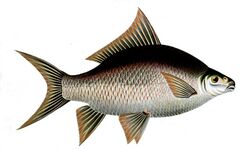Biology:Catla
| Catla | |
|---|---|

| |
| Young catla | |
| Scientific classification | |
| Domain: | Eukaryota |
| Kingdom: | Animalia |
| Phylum: | Chordata |
| Class: | Actinopterygii |
| Order: | Cypriniformes |
| Family: | Cyprinidae |
| Subfamily: | Labeoninae |
| Genus: | Labeo |
| Species: | L. catla
|
| Binomial name | |
| Labeo catla (F. Hamilton, 1822)
| |
| Synonyms | |
| |
Catla (Labeo catla), (Bengali: কাতলা, romanized: kātlā) also known as the major South Asian carp, is an economically important South Asian freshwater fish in the carp family Cyprinidae. It is native to rivers and lakes in northern India , Bangladesh, Myanmar, Nepal, and Pakistan , but has also been introduced elsewhere in South Asia and is commonly farmed.[1][2]
In Nepal and neighbouring regions of India, up to Odisha, it is called Bhakura.
Catla is a fish with large and broad head, a large protruding lower jaw, and upturned mouth. It has large, greyish scales on its dorsal side and whitish on its belly. It reaches up to 182 cm (6.0 ft) in length and 38.6 kg (85 lb) in weight.[2]
Catla is a surface and midwater feeder. Adults feed on zooplankton using large gill rakers, but young ones feed on both zooplankton and phytoplankton. Catla attains sexual maturity at an average age of two years and an average weight of 2 kg (4.4 lb).
Taxonomy
The catla was formerly listed as the only species in the genus Catla, but this was a synonym of the genus Gibelion.[1][2] More recently, Catalog of Fishes has moved this species to Labeo.[3] This species has often been confused with the giant barb (Catlocarpio siamensis) of south-east Asia as the two taxa bear an extraordinary resemblance to each other, especially in their very large heads.[1]
Aquaculture
It is one of the most important aquacultured freshwater species in South Asia.[4][5] It is grown in polyculture ponds with other carp-like fish, particularly with the roho labeo (Labeo rohita) and mrigal carp. The reported production numbers have increased sharply during the 2000s, and were in 2012 about 2.8 million tonnes per year.[6]
Catla is sold and consumed fresh, locally and regionally. It is transported on ice. Fish of 1–2 kg (2.2–4.4 lb) weight are preferred by consumers.[6]
References
- ↑ 1.0 1.1 1.2 1.3 Tenzin, K. (2010). "Gibelion catla". IUCN Red List of Threatened Species 2010: e.T166425A6206451. doi:10.2305/IUCN.UK.2010-4.RLTS.T166425A6206451.en. https://www.iucnredlist.org/species/166425/6206451. Retrieved 6 December 2023.
- ↑ 2.0 2.1 2.2 Froese, Rainer and Pauly, Daniel, eds. (2017). "Gibelion catla" in FishBase. September 2017 version.
- ↑ Eschmeyer W (2014) Cyprinus catla CAS Catalog of Fishes
- ↑ Food and Aquaculture Organization of the United Nations, Cultured Aquatic Species Information Programme: Catla catla (Hamilton, 1822) http://www.fao.org/fishery/culturedspecies/Catla_catla/en
- ↑ de Graaf, Gertjan; Latif, Abdul (2002). "Development of freshwater fish farming and poverty alleviation: A case study from Bangladesh". Aquaculture Asia 7 (2): 5–7. http://www.nefisco.org/downloads/DevelopmentOfFreshwaterFishFarming.pdf. Retrieved 6 December 2023.
- ↑ 6.0 6.1 Catla catla (Hamilton, 1822) FAO Fisheries and Aquaculture Department, Cultured Aquatic Species Information Programme
- Catla catla - http://en.bdfish.org/2010/02/catla-catla-catla-hamilton-1822/.BdFISH
- Menon, A.G.K. 1999 Check list - fresh water fishes of India. Rec. Zool. Surv. India, Misc. Publ., Occas. Pap. No. 175, 366 p. ISBN 9788185874159
Wikidata ☰ Q1051224 entry
 |



